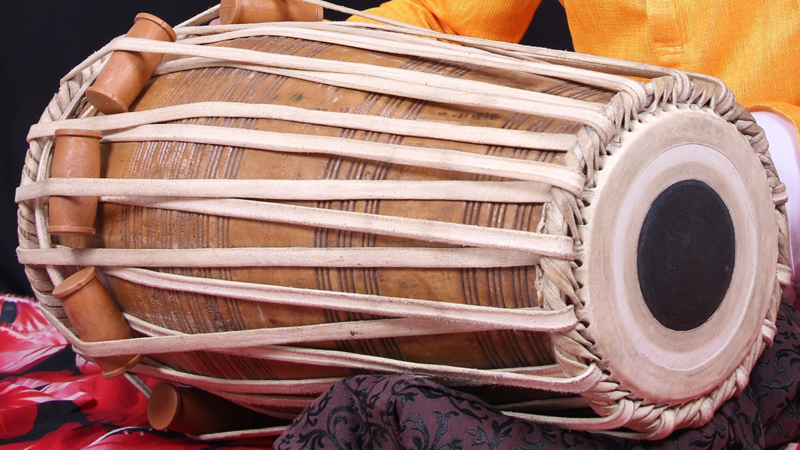Pakhavaj

The pakhavaj is a barrel-shaped, two-headed drum, originating from the Indian subcontinent, a variant and descendant of the older mridangam. The kendang of Maritime Southeast Asia is a distant relative of the pakhawaj and other South Asian double-headed drums.
It is the percussion instrument most commonly used in the dhrupad style of Indian classical music and less often used as a rhythm accompaniment for various other sub-forms of music and dance performances (e.g. kathak). Unlike mridangam, it is made of wood and has a low, mellow tone that is quite rich in harmonics. The sides of the pakhawaj are made with animal skin (often goat skin). The pakhavaj players place the instrument horizontally in front of themselves as they sit on the floor with legs crossed. The players may sometimes place a cushion under the narrower treble face to lift it slightly. A right-handed person places the larger bass-skin on the left side and the treble skin on the right. The bass face tends to be smeared with some fresh wheat dough which acts as the kiran and gives a vivid bass sound to the pakhavaj.
The tuning of Pakhavaj is similar to that of the tabla - with the wooden wedges placed under the tautening straps. Due to the varied thickness of the skin that covers the treble face, the treble face can produce at least two tones that are a semitone apart. For example, if hitting the centre (the bol दिन din) is tuned to produce the note C then hitting closer to the edge (with the bol ता for example) could produce the note C#. The fine tuning can be done with the woven outer ring (गजरा - gajra) which is an extension of the skin that the face is made of. It is only on the bass skin where a freshly made batter (or dough) of (wheat) flour and water is applied to provide enhance the low-pitched sound.
The word पखावज - pakhāvaja or pakhavāja is of Prakrit origin, whose Sanskrit equivalent is पक्षवाद्य pakṣavādya. This word is derived from the words पक्ष pakṣa ("a side"), and वाद्य vādya ("a musical instrument"). It is said that during the 14th century, the great mridangists experimented with the materials used in mridang construction and finally started using wood for the main body as opposed to the original clay. Thus, a new name pakhavaj emerged, whilst the older name, mridang was still used.
Technique
पखावज एक वाद्ययंत्र है। यह उत्तर-भारतीय शैली का ढ़ोलक (ड्रम) है। यह मृदंग के आकार प्रकार का परन्तु उससे कुछ छोटा एक प्रकार का बाजा है। तबले की उत्पत्ति इसी यंत्र से हुई है। कहा जाता है कि अमीर खुसरो पखावज बजारहे थे। उसी समय यह दो टुकड़ों में टूट गया। तब उन्होने इन टुकड़ों को बजाने की कोशिश की जो कि काम कर गया। इस प्रकार तबले का जन्म हुआ। .
पखावज वादक भारतीय वाद्यों में से एक पखावज बजाने वाले को कहा जाता है। पखावज उत्तरी भारत का एक थाप यंत्र है। मृदंग, पखावज और खोल लगभग समान संरचना वाले वाद्य यंत्र हैं।
- आधुनिक काल में गायन, वादन तथा नृत्य की संगति में पखावज का प्रयोग विशेष तौर पर किया जाने लगा है।
- भारत के प्रसिद्ध पखावज वादकों के नाम इस प्रकार हैं-
- पंडित मदन मोहन
- पंडित भोलानाथ पाठक
- पंडित अमरनाथ मिश्र
Tags
- Log in to post comments
- 4458 views
